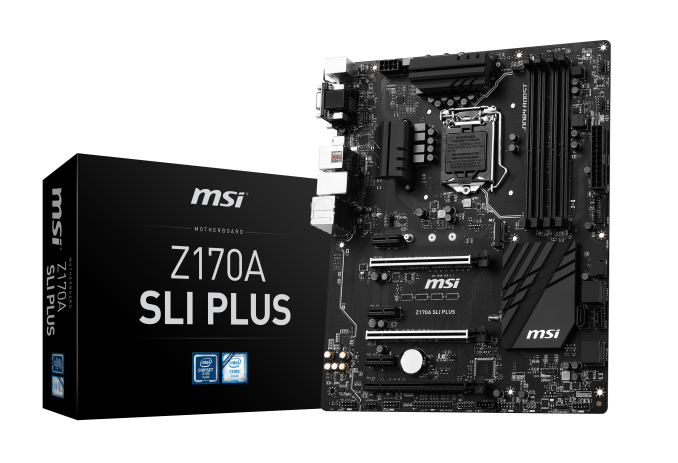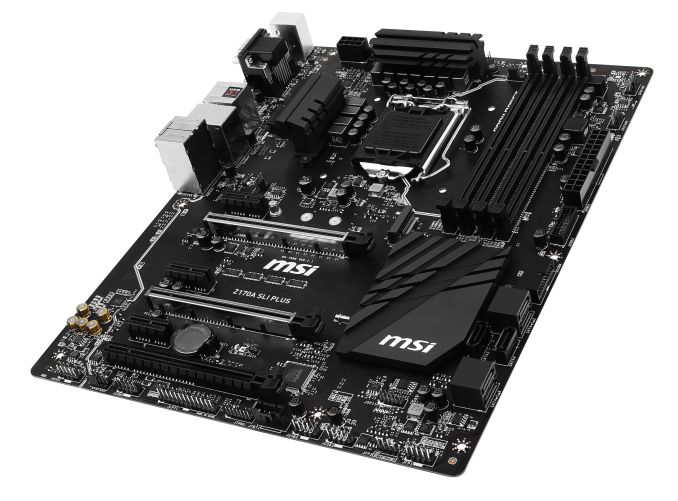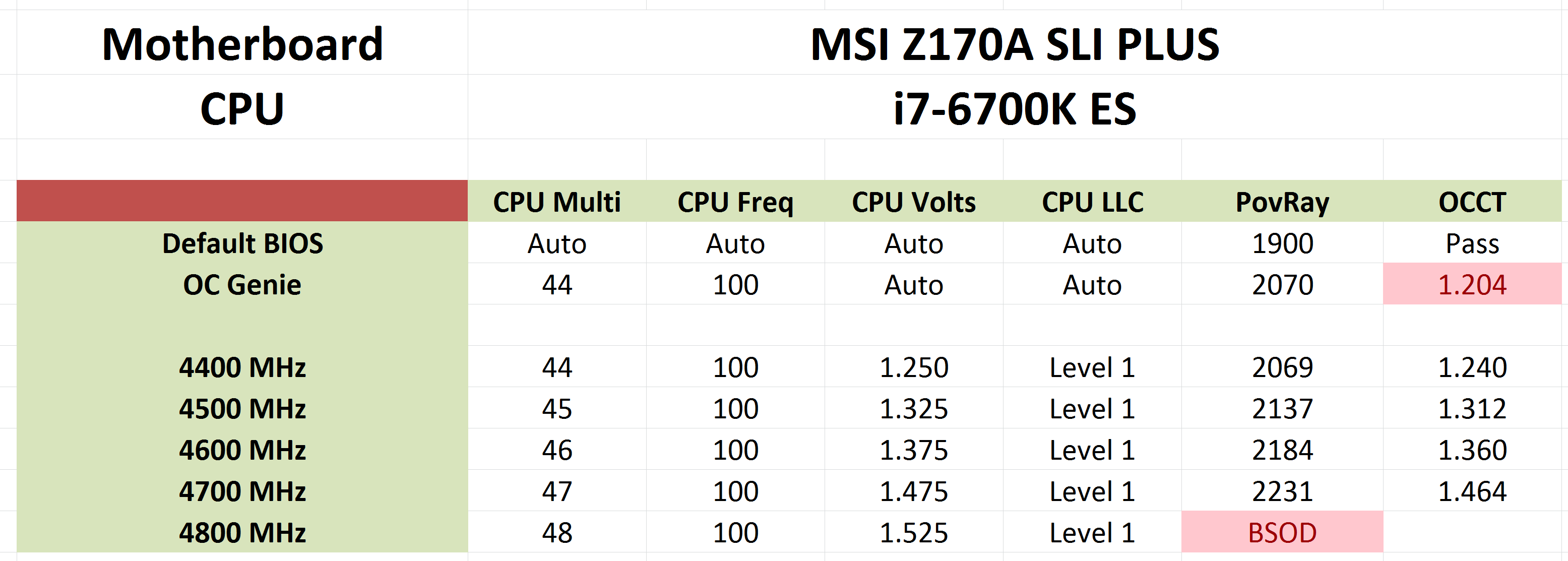The MSI Z170A SLI PLUS Review: Redefining the Base Line at $130
by Ian Cutress on April 13, 2016 8:00 AM EST- Posted in
- Motherboards
- MSI
- Skylake
- Z170

MSI’s motherboard range seems to expand every generation. Alongside the channel range, there’s the MSI Gaming, micro-ATX gaming, OC Certified, Krait, ECO, SLI PLUS, PC Mate and some I probably can’t think of. Each set can have a chipset mix, depending on their target market. The SLI PLUS line is relatively new, with the Z170A SLI PLUS in this review being the latest model. The goal of the SLI PLUS is form, function and application at a low price, with a few future-proof features and enough hardware for most PC enthusiasts systems. They seem to sell well, so we got a sample in to see the fuss. Two word verdict: pleasantly surprised. Read on to see why.
Other AnandTech Reviews for Intel’s 6th Generation CPUs and 100-Series Motherboards
Skylake-K Review: Core i7-6700K and Core i5-6600K - CPU Review
Comparison between the i7-6700K and i7-2600K in Bench - CPU Comparison
Overclocking Performance Mini-Test to 4.8 GHz - Overclocking
Skylake Architecture Analysis - Microarchitecture
Z170 Chipset Analysis and 55+ Motherboards - Motherboard Overview
Discrete Graphics: An Update for Z170 Motherboards - PCIe Firmware Update
Price Check: Intel Skylake i7-6700K and i5-6600K - Latest Skylake Price Check (3/29)
100-Series Motherboard Reviews:
Prices Correct at time of each review
($500) The GIGABYTE Z170X-Gaming G1 Review
($500) The ASUS Maximus VIII Extreme Review
($250) The ASUS Maximus VIII Impact Review
($240) The ASRock Z170 Extreme7+ Review
($230) The MSI Z170 Gaming M7 Review
($208) The GIGABYTE Z170-UD5 TH Review
($165) The ASUS Z170-A Review
($130) The MSI Z170A SLI PLUS Review (this review)
($125) The Supermicro C7H170-M Review
To read specifically about the Z170 chip/platform and the specifications therein, our deep dive into what it is can be found at this link.
MSI Z170A SLI PLUS Overview
At $130 only a few overclocking class motherboards sit in this area. It marks the cross over for ATX motherboards between the high cost H series chipset motherboards (ones with special features or extra controllers such as dual network plus WiFi) and base cost Z series models, just because a motherboard that can support SLI and overclock needs to be engineered to cope with at least a 10-20% increase in frequency and 75W to each GPU. This means more efficient power delivery, more reliability, tweaking and tuning to ensure stability, a BIOS and software package with more options and the ability to use as many of the PCIe lanes from the chipset as possible. Nonetheless, the Z series motherboards nearer $100 tend to be a cost-down implementation.
The SLI PLUS comes into this market in a serious way. It comes in as one of the cheapest ways to implement SLI in the Skylake platform via the x8/x8 PCIe separation, but in many ways it also marks several years of movement from MSI to build a brand and improve the aesthetic. The MSI Z170A SLI PLUS does not look like a $130 motherboard on a first look, due to the coating used to cover up obvious trace lines but also the color consistency between black and dark grey used on the heatsinks, slots and ports. It marks in impressive change at just how regulated an aesthetic can get despite the low price, a feature normally reserved for more expensive motherboards.
For features, aside from support for 2-way SLI and PCIe guard plates to protect from large graphics cards, the motherboard gives both a USB 3.1 Type-C port on the back (provided by ASMedia’s ASM1142 controller) and a fully capable PCIe 3.0 x4 M.2 slot up to 2280 without compromising the utility of other features. The latter comes via four of the 20 PCI lanes on the chipset, one of the benefits of the 100-series chipset over previous generations. Normally in 2016 just saying a motherboard has M.2 x4 and 3.1-C is par for the course and we expect to see that on almost all of the ones that we review, but it might not be expected on a $130 product. The motherboard also uses the standard high-end audio codec (Realtek ALC1150) and network controller (Intel I219-V) that we see on $350+ motherboards, both of which are usually easy cost-down areas in cheaper products. The audio codec is improved in some of the same ways as the more expensive motherboards (PCB separation, filter caps) and it still performs very well.
For our performance metrics, the SLI PLUS doesn’t implement MultiCore Turbo by default so it falls into the second half of the table for CPU performance, but an overclock is just a click away in either the BIOS or software. But the power consumption is one of the lowest we’ve seen due to the de-complication of the design, and the POST times are in the better half of the table for the same reason. DPC Latency has been fairly dichotomous on Z170, both good and bad, but the SLI PLUS is on the good side of the split.
The BIOS and Software combination from MSI works very well. MSI is using their latest BIOS design from the high-cost motherboards at this price point, having developed a new ‘easy mode’ entry screen for Skylake last year. The software package has some minor flaws (such as voltage selection) but on the whole is easy to use and MSI’s Live Update package still shines through as a top solution from any motherboard manufacturer.
Every time we get a new motherboard in for review, my first task is to take it out of the box and have a very good look around to determine the features, controllers and layout before I look at specification sheets. The goal here is to determine how much is immediately obvious, but also to see which market it is aimed for and the feeling of what price might be paid. The MSI Z170A SLI PLUS has a solid base feature set, with a few extras over the specifications, and the presentation/layout gave the impression of a very streamlined design. When I checked the MSRP, I was surprised (my initial estimate was too high...!) and MSI has found a really nice price point for a board breezed through our testing.
Quick Links to Other Pages
Board Features, In The Box
Visual Inspection and Test Setup
BIOS
Software
System Performance (Audio, USB, Power, POST Times on Windows 7, Latency)
CPU Performance, Short Form (Office Tests and Transcoding)
Gaming Performance 2015 (R7 240, GTX 770, GTX 980)
Conclusions
Quick Board Feature Comparison
| Motherboard Comparison | ||
| MSI Z170A SLI PLUS | ||
| Socket | LGA1151 | LGA1151 |
| MSRP at Review | $130 | $230 |
| DRAM | 4 x DDR4 | 4 x DDR4 |
| PCIe Layout | x8/x8 | x8/x8 |
| BIOS Version Tested | 1.4 | 142 |
| MCT Enabled Automatically? | No | Yes |
| USB 3.1 (10 Gbps) | ASMedia ASM1142 1 x Type-C |
ASMedia ASM1142 1 x Type-A 1 x Type-C |
| M.2 Slots | 1 x PCIe 3.0 x4 | 2 x PCIe 3.0 x4 |
| U.2 Ports | No | No |
| Network Controller | 1 x Intel 219-V | 1 x Killer E2400 |
| Audio Controller | Realtek ALC1150 | Realtek ALC1150 |
| HDMI 2.0 | No | No |
MSI Z170A SLI PLUS Overclocking
Experience with MSI Z170A SLI PLUS
Automatic overclocking options from MSI have changed a little bit of the past couple of years, with the OC Genie name moving from a small single automatic overclock selection several generations ago moving to a progressive overclock dial for the high end models this generation. The Z170A SLI PLUS goes back to that single overclock selection, despite the fact that the progressive overclock could have been implemented software only. The single point overclock this time is a bit more aggressive than previous generations, but not overly so: whereas before we would get 3-5% frequency jumps, here there is a 10% jump with the i7-6700K moving from 4.0 GHz to 4.4 GHz on all cores. However, MSI is conservative on voltage and this overclock failed our stress testing.
For manual overclocking, given the price segment and hardware on board, we weren’t expecting the best OC performance and the end result was still a good mark in the sand.
Methodology
Our standard overclocking methodology is as follows. We select the automatic overclock options and test for stability with PovRay and OCCT to simulate high-end workloads. These stability tests aim to catch any immediate causes for memory or CPU errors.
For manual overclocks, based on the information gathered from previous testing, we start off at a nominal voltage and CPU multiplier, and the multiplier is increased until the stability tests are failed. The CPU voltage is increased gradually until the stability tests are passed, and the process repeated until the motherboard reduces the multiplier automatically (due to safety protocol) or the CPU temperature reaches a stupidly high level (100ºC+). Our test bed is not in a case, which should push overclocks higher with fresher (cooler) air.












62 Comments
View All Comments
Dr. Swag - Wednesday, April 13, 2016 - link
Hey Ian, any word on how far along the x4 845 review your promised a while back is? I'm very interested in it but it's been quite a while now. I know you've been busy on other reviews but just want to know how that's going. If you don't know what I'm talking about:http://www.anandtech.com/comments/10000/who-contro...
Ian Cutress - Wednesday, April 13, 2016 - link
It's taken a couple of weeks, but I think the X4 845 is tested (regular and OC). Just need to run through a couple of older gen chips to see difference / IPC - X4 760K only arrived yesterday. Should have the 860K in there as well, all three tested at stock and 3G for comparison - CPU (office, synthetic and realworld tests) and gaming performance are both covered. I've also got a set of i3 parts on the go, most of the new E3 Xeons, an FX retest and new A10 reviews in flight, so apologies for the delays. If you've been following my twitter feed recently, I've been updating the test work flow to hopefully optimize this for the future... :)Dr. Swag - Wednesday, April 13, 2016 - link
Awesome man! Just take your time and don't rush it :). Thanks for the reply/update.owan - Wednesday, April 13, 2016 - link
I wish more mid-high end boards would sport color schemes like this. If you want to do a mod project, this is like a blank slate that can work with nearly any theme. Unfortunately high end boards usually have one gaudy color that you can't ignore or alter without significant work. I get that its all part of the branding, but having such a neutral color scheme would have been nice when doing my own project.... I found myself having to use red in my build just to make my Asus ROG board (purchased prior to the project) work, even though I don't really care for the color.ImSpartacus - Wednesday, April 13, 2016 - link
I know! Why is a tasteful black & gray so troubling to get right?Questor - Wednesday, April 13, 2016 - link
Amen to that! I saw the MSI X99A Godlike Gaming Carbon and dropped three credit cards on the floor trying to get the one I initially grabbed! At that point, I had not idea what socket, what the specs were and what was generally compatible. I saw the awesome black and shiny combo, like a black muscle car with lots of chrome and went lights out. I came too when my walked up to me and asked why I had my cards out and why is that big black and metal thing $600.00?!!!Impulses - Thursday, April 14, 2016 - link
Agreed, this was a factor in me picking the ASUS Z170-A, seemed like every other board in the same price range (before this MSI, which didn't come out until the end of last year) was pimping a red scheme or something bolder.Oxford Guy - Wednesday, April 13, 2016 - link
Give us a Skylake that makes use of its EDRAM controller (by having EDRAM) and then I'll care about this generation of boards.Oxford Guy - Wednesday, April 13, 2016 - link
Probably in the same file with the GTX 960. "Coming real soon."KLC - Wednesday, April 13, 2016 - link
So I'm in the early stages of thinking about a new build. I don't do this often, I'm currently using aQ6600 box I built almost 8 years ago. I don't game, I don't overclock, I'll use the integrated graphics with an SSD and HDD for storage. Most uses are standard office apps, web browsing plus media, and photography using Adobe Lightroom and Photoshop with a little video using Sony Vegas. There is a bewildering array of motherboards out there. I want a quality mb with quality components, good sound and the latest USB ports but since I'm not on the extreme bleeding edge I don't need to spend a fortune for a mb. This one looks like it might be a good fit for me. Am I right or are there other mbs out there I should look at?